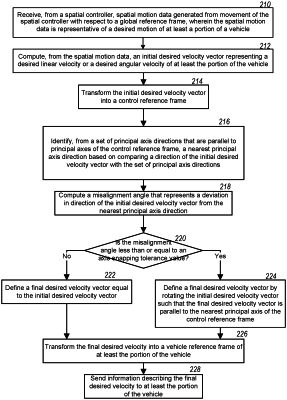| CPC G05D 1/0016 (2013.01) [B62D 57/02 (2013.01); G05D 1/0033 (2013.01); G05D 1/0038 (2013.01); G05D 1/0223 (2013.01); G05D 1/222 (2024.01); G05D 1/223 (2024.01); G05D 1/224 (2024.01); G05D 1/2247 (2024.01); G05D 1/2248 (2024.01); G05D 1/24 (2024.01); G05D 1/65 (2024.01); G06F 3/0346 (2013.01)] | 20 Claims |

|
1. A method of detecting an intent of vehicle control, the method comprising:
receiving gesture data generated from a user interface with respect to a global reference frame, wherein the gesture data is representative of a desired motion of at least a portion of a vehicle;
computing, from the gesture data, an initial desired velocity vector representing a desired linear velocity or a desired angular velocity of at least the portion of the vehicle;
transforming the initial desired velocity vector from the global reference frame into a control reference frame;
identifying, from a set of principal axis directions that are parallel to principal axes of the control reference frame, a nearest principal axis direction based on comparing a direction of the initial desired velocity vector with the set of principal axis directions;
computing a misalignment angle that represents a deviation in the direction of the initial desired velocity vector from the nearest principal axis direction;
upon determining that the misalignment angle is less than or equal to an axis-snapping tolerance value, defining a final desired velocity vector by rotating the initial desired velocity vector such that the final desired velocity vector is parallel to the nearest principal axis direction; and
sending information indicating the final desired velocity vector to at least the portion of the vehicle.
|